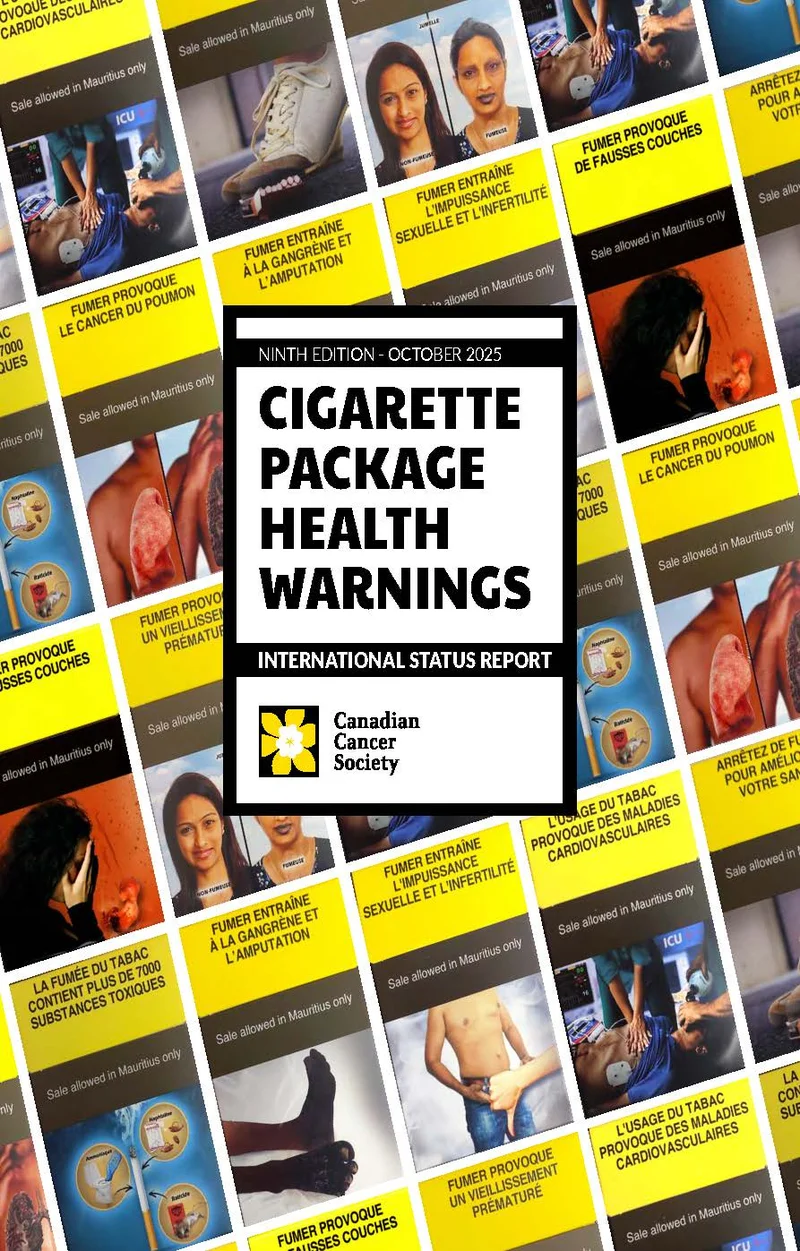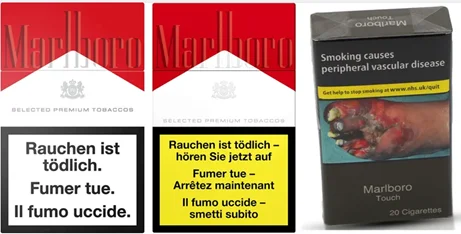- 28.11.2025
- News
New Global Report Shows Switzerland’s Cigarette Warnings Lag a Decade Behind the Rest of the World
Tobacco packaging has long been one of the industry’s most powerful marketing weapons — a miniature billboard that travels everywhere a smoker goes. When traditional advertising was banned from television, billboards, and sports sponsorships, tobacco companies shifted their creativity and budgets to the pack itself, transforming it into a seductive tool for branding, social aspiration, and denial of harm.
Public-health authorities, in turn, have reclaimed the same surface as a communication channel for truth and prevention. Over the past two decades, cigarette packages have become one of the most effective and low-cost health-education tools in the world. They reach smokers and non-smokers alike, 24 hours a day, across every social group, without relying on media campaigns or individual interventions.
Since the early 2000s, the global movement for graphic health warnings and plain packaging has accelerated dramatically, supported by the World Health Organization’s Framework Convention on Tobacco Control (FCTC), particularly Article 11, which requires that health warnings cover at least 30 % — and preferably 50 % or more — of the pack’s main display areas. From Canada’s pioneering introduction of picture warnings in 2001 to Australia’s landmark implementation of plain packaging in 2012, the global landscape has shifted from minimalist text boxes to shocking, full-colour depictions of disease, addiction, and loss.
The 2025 International Status Report on Cigarette Package Health Warnings, released in November 18, 2025 by the Canadian Cancer Society, takes stock of this transformation and reveals the current global hierarchy of progress and inertia. It provides an authoritative, data-driven snapshot of how 212 countries and jurisdictions regulate tobacco packaging — ranking them by the size of their warnings, the presence of pictorial messages, and the adoption of plain or standardized packaging.

Canadian Cancer Society
What’s New in the 2025 Report
The 2025 edition of the International Status Report on Cigarette Package Health Warnings captures a world in motion — one where packaging has become a central front line in the battle over tobacco control, and where policy innovation is spreading faster than ever before.
The findings demonstrate both extraordinary global progress and persistent gaps. A growing majority of the world’s population — 66 % — is now protected by picture-based warnings. This represents an increase from 126 countries in 2020 to 140 countries and jurisdictions in 2025, a staggering leap from only 24 countries in 2008. In practical terms, more than two billion additional people are now exposed to stronger, more visible health warnings every time they see or handle a cigarette pack.
Dozens of governments have expanded the size, visibility, and rotation frequency of their warnings, recognizing that static, text-only messages quickly lose impact. Countries such as Gambia, Turkmenistan, Iceland, Malaysia, and Uzbekistan have all increased their warning sizes since the last edition of the report, while Nepal has gone even further — adopting a world first: 100 % coverage on both sides of cigarette packs. Although delayed by a legal challenge, Nepal’s move represents a symbolic milestone: the first country to make the brand itself completely disappear on the main pack surfaces.
Meanwhile, a growing number of countries have introduced additional communication layers inside the pack or on the cigarettes themselves. Canada became the first country in 2024 to require direct health warnings on individual cigarettes, followed in 2025 by Australia. These “on-stick warnings” are visible at every puff, reach consumers even when cigarettes are sold individually, and send a powerful signal that there is “no safe cigarette.”

Health Canada
Australia also became only the second country — after Canada — to implement mandatory package inserts featuring cessation information and health education messages. Inserts, long used by the tobacco industry for promotional purposes, are being repurposed to provide supportive, evidence-based information for smokers who want to quit.
The report further highlights the continuing global shift toward plain packaging — a measure that removes all logos, colours, and brand designs from cigarette packs, leaving only a standardized drab background and text. As of 2025, 27 countries have adopted plain packaging and 44 in total are implementing or developing legislation. Newly added to the list are Iceland and Syria, with implementation foreseen by 2027.
Beyond the numbers, the 2025 edition reflects a qualitative shift: an increasing convergence between countries of very different income levels. What was once a pioneering measure limited to a handful of wealthy nations has now spread to small island states, low-income countries, and entire regions. From Timor-Leste and Mauritius to Türkiye and New Zealand, countries are progressively dismantling the tobacco industry’s last marketing stronghold — the cigarette pack itself.
Yet, as the report carefully notes, 47 countries — including 39 Parties to the WHO FCTC — still fail to meet even the minimum requirement of 30 % coverage mandated by international law. In many of these, the tobacco industry continues to enjoy near-total freedom to design attractive packaging that undermines health warnings and misleads consumers about relative risks.
The 2025 report thus presents a dual picture: one of impressive policy momentum and stagnant exceptions. It celebrates a growing international consensus that tobacco packages must tell the truth about the product they contain — but it also shines a harsh light on wealthy laggards, including Switzerland, where outdated and poorly visible warnings remain far below global standards.
Switzerland: no improvement, aside a bit of cosmetic yellow
In Switzerland, all efforts to introduce plain packaging during the debate on the new Federal Tobacco Products Act (LPTab) — which entered into force on October 1st, 2024 — were systematically blocked in Parliament under pressure from the tobacco lobby. The result, after years of paralysis, is a reform that amounts to little more than cosmetic change.
Health warnings have switched from white to yellow, and the pictorial images will finally be renewed — but still confined to the back of the pack, rather than occupying the most visible space on the front as recommended by the WHO FCTC. The most graphic and effective images, proven by international research to trigger stronger quit intentions, have been carefully excluded.
Of the 140 countries and jurisdictions that require picture warnings, Switzerland is one of only 11 where these warnings can appear only on the reverse side of the pack. Switzerland has not increased the size of its warnings since 2010, despite the fact that a large number of other countries have done so, including all EU countries.

A little yellow instead of white, but the images remain behind. On the right, neutral English packaging from the same brand.
One year after the law came into force, the situation on the ground is deeply disappointing. Field checks conducted in late September 2025 in about fifteen retail outlets between Bern and Fribourg revealed that less than one-third of cigarette packs displayed the new warnings. Worse still, no snus or nicotine pouch products — which already failed to comply with basic labelling requirements — had been updated at all. The same is true for most e-cigarette products, where only a few isolated brands carry the new messages. Online retailers continue to show old, non-compliant visuals, even for standard cigarette brands.
Although the new law granted the industry a full year of transition, enforcement appears virtually nonexistent. Manufacturers and retailers are now being given even more time to “sell off their old stock” — with no clear oversight mechanism to determine when those stocks are truly depleted, or whether they are quietly being replenished.
For a country that prides itself on regulatory precision, Switzerland’s approach stands out as an example of deliberate inertia. While over 130 countries worldwide have implemented large, rotating picture warnings — and 27 have adopted plain packaging — Switzerland remains stuck with outdated, fragmented, and weak labelling that protects the tobacco industry far more effectively than it protects public health.